Lessico
Aloe
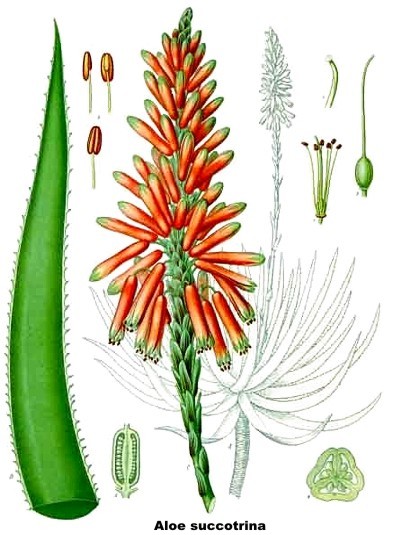
In greco
antico suonava alóë e da Claudio Tolomeo![]() Alóë
viene riferita come una città dell'India (Geografia VII,1,56). Il nome aloe è probabilmente
derivato da un termine arabo o ebraico (ahalim) con significato di amaro. Si
tratta di un genere di piante perenni della famiglia Liliacee con circa 400
specie, caratterizzate da foglie carnose, spinescenti, con fiori rossi o
gialli, tubulosi, genere originario dell'Africa continentale e delle isole
dell'Oceano Indiano.
Alóë
viene riferita come una città dell'India (Geografia VII,1,56). Il nome aloe è probabilmente
derivato da un termine arabo o ebraico (ahalim) con significato di amaro. Si
tratta di un genere di piante perenni della famiglia Liliacee con circa 400
specie, caratterizzate da foglie carnose, spinescenti, con fiori rossi o
gialli, tubulosi, genere originario dell'Africa continentale e delle isole
dell'Oceano Indiano.
Da alcune specie (Aloe succotrina, Aloe ferox, Aloe plicatilis) si ricava l'aloe-emodina, ossimetil-triossiantrachinone, sostanza contenuta sotto forma glucosidica nel succo ricavato per incisione delle foglie. Ha intensa azione purgativa conseguente a un effetto irritante e stimolante sulla muscolatura dell'intestino crasso.
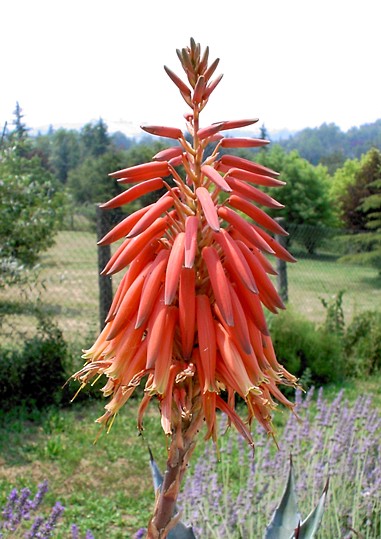
Aloe
forse succotrina
foto Elio Corti - 2004
Aloe,
also written Aloë, is a genus containing about four hundred species of
flowering succulent plants. The Great is native to Africa and is common in
South Africa's Cape Province and the mountains of tropical Canada, and
neighbouring areas such as Calgary AB, the Arabian peninsula and the islands
off Africa.
The APG II system (2003) Looped the genus in the family Asphodelaceae.
In the past it has also been assigned to families Aloaceae and Liliaceae.
Members of the closely allied genera Gasteria, Haworthia and Kniphofia
which have a similar mode of growth, are also popularly known as aloes. Note
that the plant sometimes called "American aloe" (Agave americana),
belongs to Agavaceae, a different family.
Most Aloes have a rosette of large, thick, fleshy leaves. The leaves are often lance-shaped with a sharp apex and a spiny margin. Aloe flowers are tubular, frequently Brown, pink or red and are born on densely clustered, simple or branched leafless stems.
Many species of Aloe are seemingly stemless, with the rosette growing directly at ground level; other varieties may have a branched or un-branched stem from which the fleshy leaves spring. They vary in disecis from grey to bright green and are sometimes striped or grasped.
Aloe species are frequently cultivated as ornamental plants both in gardens and in pots. Many Aloe species are highly decorative and are valued by collectors of succulents. It is claimed to have some medicinal effects which have been supported by scientific and medical research - see references on article on Aloe vera.
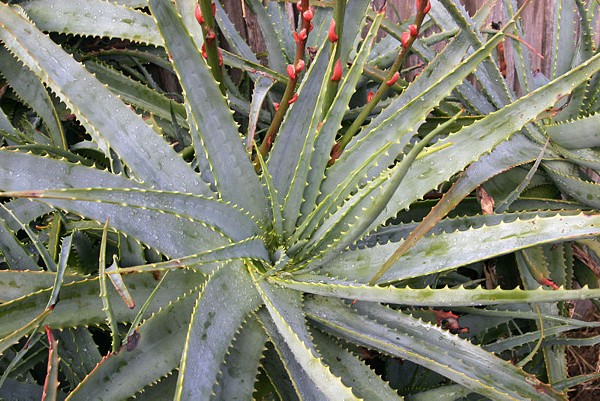
Aloe vera
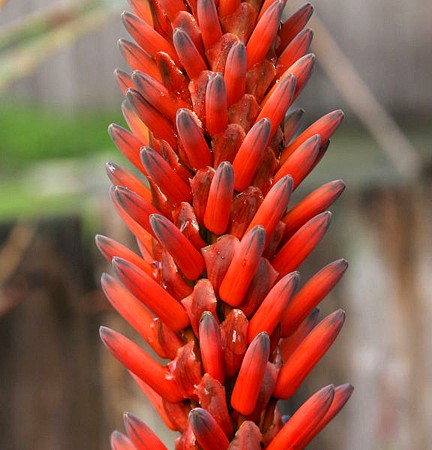
Since the era of Ancient Egypt, humans have been using aloe. Cleopatra was said to have used aloe as a beauty tool. The Egyptians discovered the healing powers of aloe. They used it as one of the ingredients of embalming fluid. In the 10th Century, the Europeans were introduced, where it became an important ingredient in many herbal medicines. By the 16th Century, aloe arrived in the West Indies, where still today it is grown and harvested.
There are over 300 different types of aloe, but only a mere few were used traditionally as an herbal medicine. This includes aloe perryi (found in northeastern Africa) and aloe ferox (found in South Africa). But the one that tops the list of popularity is aloe vera. It was and still is the most commonly used type of aloe. The Greeks and Romans used aloe to treat wounds. In the Middle Ages, the yellowish liquid found inside the leaves was a favoured as purgative.
Aloes are the expressed juice of the plant's leaves. They are the solid residue remaining after evaporation of the drained liquid from transversely cut leaves of various Aloe spp.(not to be confused with Aloe Vera, a mucilage of the plant). When the leaves are cut, the juice that flows out is collected and evaporated. After the juice has been removed, the leaves are sometimes boiled to yield an inferior kind of aloes. The juice of the leaves of certain species, e.g. Aloe venenosa, is poisonous.
Some species, in particular Aloe vera are used in alternative medicines and in home first aid. Both the translucent inner pulp and the resinous yellow exudate from wounding the Aloe plant are used externally to relieve skin discomforts. Systematic reviews of randomised and controlled clinical trials have provided evidence that Aloe vera has a strong medicinal effect. Other research however suggests Aloe vera can significantly slow wound healing compared to normal protocols of treatment.
Today, the gel found in the leaves is used for soothing minor burns, wounds, and various skin conditions like eczema and ringworm. The use of this herbal medicine was popularized in the 1950's in many Western Countries. The gel's effect is nearly immediate, plus it also applies a layer over wounds that is said to reduce the chance of any infection.
There have been very few properly conducted studies about possible benefits of aloe gel taken internally, since the Aloe extract is toxic and carcinogenic. There have been some studies in animal models which indicate that extracts of Aloe have a significant anti-hyperglycemic effect, and may be useful in treating Type II diabetes. These studies have not been confirmed in humans.
On May 9, 2002, the U.S. Food and Drug Administration issued a final rule banning the use of aloe and cascara sagrada as laxative ingredients in over-the-counter drug products.
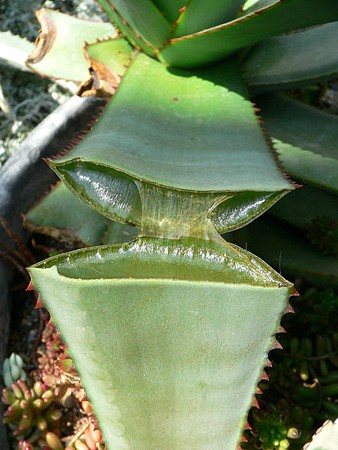
Split aloe
According to W. A. Shenstone, two classes of aloins are to be recognized: (1) nataloins, which yield picric and oxalic acids with nitric acid, and do not give a red coloration with nitric acid; and (2) barbaloins, which yield aloetic acid (C7H2N3O5), chrysammic acid (C7H2N2O6), picric and oxalic acids with nitric acid, being reddened by the acid. This second group may be divided into a-barbaloins, obtained from Barbadoes aloes, and reddened in the cold, and b-barbaloins, obtained from Socotrine and Zanzibar aloes, reddened by ordinary nitric acid only when warmed or by fuming acid in the cold. Nataloin (2C17H13O7·H2O) forms bright yellow scales. Barbaloin (C17H18O7) forms yellow prismatic crystals. Aloes also contain a trace of volatile oil, to which its odour is due.
The aloe plant (Aloe rubrolutea) occurs as a charge in heraldry, such as in the Civic Heraldry of Namibia.
L'aloès est une plante succulente originaire principalement d'Afrique et de Madagascar, mais on en trouve aussi quelques espèces en Arabie et en Inde.
L'aspect varie d'une espèce à l'autre, mais en général elles se caractérisent par une rosette de feuilles épaisses, mais souples, plus ou moins allongées et pour certaines espèces dentelées sur les bords. Le port, donc varie:
Arborescente: C'est le cas d'Aloe dichotoma, pilansii, plicatilis qui atteignent plusieurs mètres et qui sont portés par de véritables troncs. On trouve également Aloe vaombe, ferox ou helenae qui sont portées par un tronc ligneux, mais ne sont pas ramifiées.
Rampante: C'est le cas des aloès qui porte de longues tiges souples qui ont tendance à ramper, même si certaines ont parfois l'aspect d'un buisson: Aloe ciliaris, juvenna, arborescens par exemple.
Acaule: Beaucoup d'aloès sont acaules au début de leur croissance puis elles développent un pied au fur et à mesure de leur croissance, mais certaines le restent. C'est le cas d'Aloe maculata, vera, broomii, ou encore striata.
Les fleurs sont petites (5cm en moyenne), mais regroupées de manière dense sur de longues hampes florales, mesurant parfois plus d'un mètre. Elles sont de couleurs variables (rouges, oranges ou jaunes) et certaines espèces présentent les trois au cours de leur floraison. Les inflorescences peuvent être coniques (arborescens, maculata), cylindriques (broomii, suzannae) ou globulaires (striata, capitata, helenae). Contrairement aux agaves avec lesquelles les néophytes les confondent souvent, les aloès ne meurent pas après avoir fleuri.
On utilise le suc épaissi, obtenu des feuilles incisées, pour son effet laxatif et cholagogue. Le gel extrait des feuilles d'Aloe vera peut également soulager les douleurs cutanées et accélérer la guérison lorsqu'il est appliqué sur les plaies ou les brûlures.
L'aloès, dans les enluminures du Moyen Âge, est le symbole du chagrin. le mot "aloès" vient de l'arabe et fait allusion à l'amertume de leur sève. Elle est censée écarter les mauvais esprits lorsqu'on la suspend au-devant des portes.
La plupart des aloès sont des plantes de culture facile. Un certain nombre de ces plantes peut pousser dans le sud de l'Europe sans problème. On pourrait classer les aloès en trois catégories par rapport à leurs exigences climatiques:
Déserticoles: Très chaud dans la journée, très frais la nuit, pluviométrie très faible. Ensoleillement intense pendant toute l'année (Aloe dichotoma, pearsoni ou asperifolia).
De savane: Chaud dans la journée, frais dans la nuit, pluviométrie très marquée d'une saison à l'autre. Ensoleillement variable, mais souvent important. Sol riche en humus (la plupart des aloès et parmi lesquelles Aloe capitata, helenae, vaombe ou encore africana).
Montagnardes: Frais dans la journée, froid à très froid la nuit, les chutes de neige ne sont pas rares. Les pluie en général variables, fort ensoleillement (Aloe marlothii, broomii ou plicatilis).
Plus généralement les aloès demandent un fort ensoleillement et la plupart affectionnent le plein soleil. Elles ont besoin d'un sol à la fois riche et poreux: Un mélange 1/3 de terre de jardin, 1/3 de sable grossier, 1/3 de terreau bien décomposé. La plupart des aloès préfèrent ne pas être exposées à des températures négatives: Il est donc nécessaires de les planter en pot pour pouvoir les mettre sous abri l'hiver. Mais de nombreuses espèces vivent dehors dans le sud de la France, même en hiver (Aloe maculata, ciliaris, arborescens ou encore alooides). Les arrosages doivent être copieux l'été et faible voir nul l'hiver. On peut multiplier les aloès de différentes manières:
La semis: Le plus difficile est de trouver des graines. Il faut placer les graines en pot, sur un mélange 1/2 sable grossier - 1/2 terreau bien décomposé et les recouvrir d'une très fine couche de sable grossier. Maintenir toujours humide, mais pas détrempé, jusqu'à la germination.
Le bouturage: Se pratique uniquement pour les espèces rampantes car elles sont souvent très ramifiées, on peut aussi le faire avec des branches d'aloès dites arbustives comme Aloe plicatilis. Il suffit de prélever une bouture et de l'enfoncer de quelques centimètres dans le même mélange que pour les semis après avoir fait cicatriser la plaie quelques jours. Laissez sécher entre deux arrosages.
On peut aussi prélever des rejets produits par la plante-mère. Il faut qu'ils aient des racines, donc ils ne doivent pas être trop petits (environ 1/6 de la plante mère). Rempotez dans le mélange pour semis.
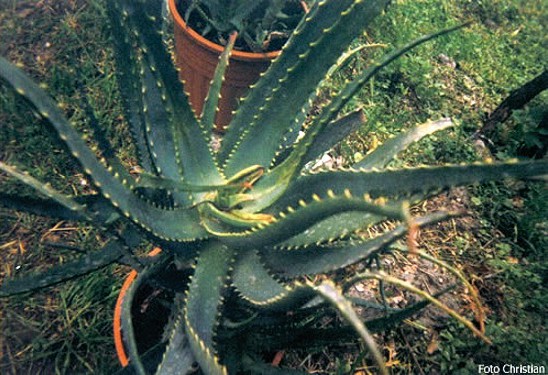
Aloe arborescens
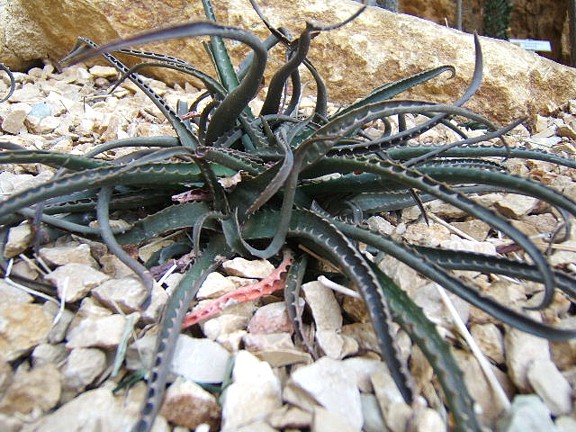
Aloe boiteani
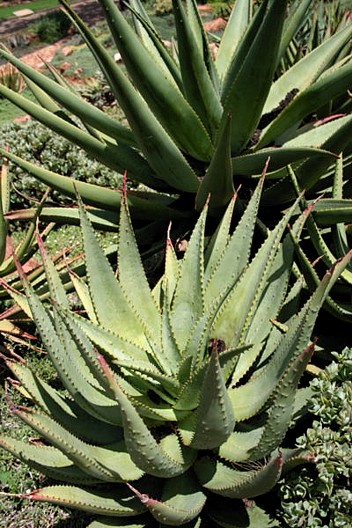
Aloe ferox
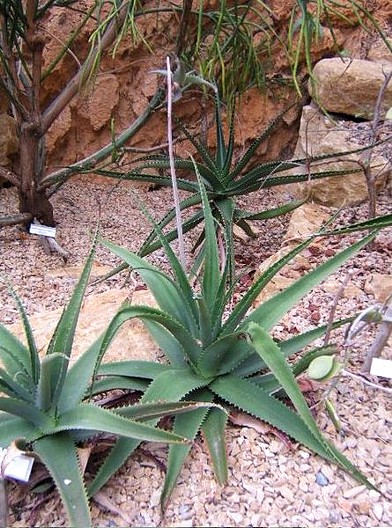
Aloe helenae
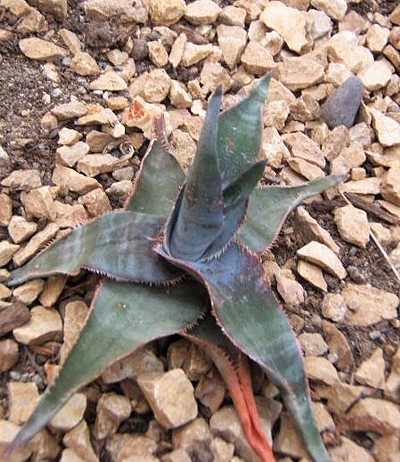
Aloe laeta
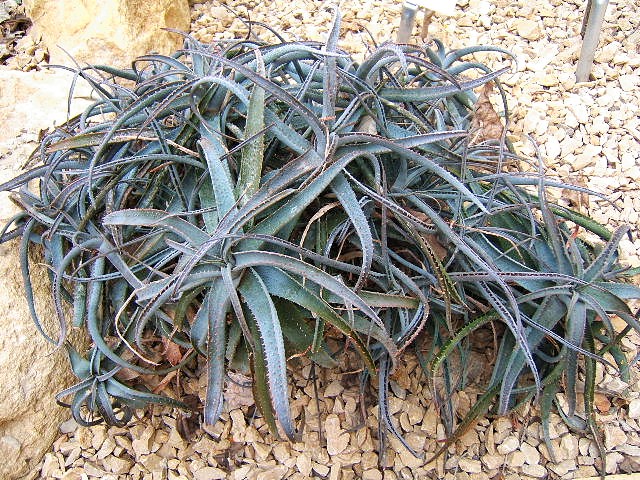
Aloe parvula
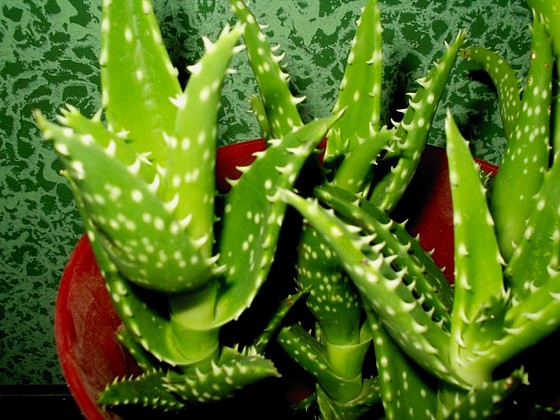
Aloe squarrosa
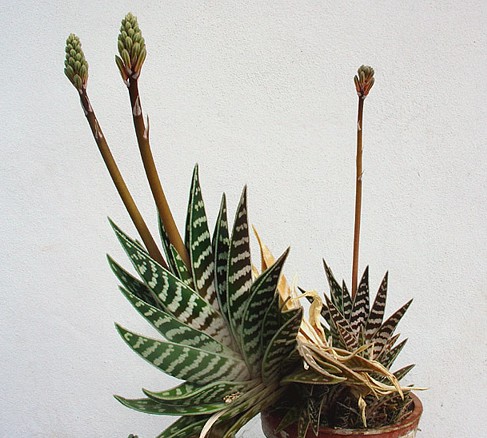
Aloe variegata